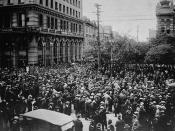The Winnipeg General Strike:
A revolution is the forcible overthrow of a government or social order, in favor of a new system (Oxford Dictionary). Does it apply to the Winnipeg General Strike in 1919? Was what happened to Winnipeg an attempt of a revolution? This essay will attempt to answer these questions.
General strikes are violent events that are unlikely to be created in a day. They are usually created from many years of bitterness. One of the events that led up to the strike was many of the soldiers that came back from World War I were not able to get their jobs back. The soldiers claimed that the "new immigrants" took their job, and now that they were jobless, the government should do something about it. However, the government did not do much. Another was the Canadian labour situation which was changed in many ways by the experience of World War I.
The workers' purchase power was low, due to the inflation and profiteering attempts by the employers. In addition, the employers also degraded craft skills, which resulted in the employees being more discontent with the government policies towards labor. In the end the labor, movement doubled it size between 1916 to 1919. Finally, during March 1919, the unhappy workers and unions were motivated by the Russian Revolution of 1917 and formed one big union. The union was called "One Big Union", and consisted of and controlled most of western Canadian and Northern Ontario labor workers.
During 1917 and 1918 growing industrial unrest swept throughout the country, especially in the western Canada. This provided an additional reason for the Anglo-Canadians to demand greater control of the community.
Officially, the strike began at 11:00a.m. on May 15 1919, which was the time appointed by the Winnipeg Trades and...


